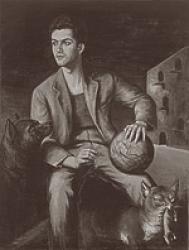Michael Ende and Mystical Thinking
 Portrait of Michael Ende by Edgar Ende, 1951
Portrait of Michael Ende by Edgar Ende, 1951During his time in Stuttgart Michael Ende was more attracted to art and literature than to the anthroposophical focus of the Waldorf school. He shared his parents’ interest in Rudolf Steiner and his work, but, as Peter Boccarius mentions in his biography of Michael Ende – Michael Ende. Der Anfang der Geschichte (Michael Ende: The Beginning of the Story – his worldview wasn’t shaped by Steiner’s anthroposophy alone. Inspired by his father’s books on the subject, Ende soon came into contact with mystical writings. During the first quarter of the twentieth century Munich was a ‘capital of mysticism’, home to numerous proponents of mystical beliefs, including Alfred Schuler, Karl Wolfskehl and Ludwig Klages. The idea of exploring eschatological questions through art appealed to the young pupil, and he became an avid reader of mystical texts.
Throughout his life Michael Ende was fascinated by philosophical theories centred on mystical ideas. ‘Edgar Ende’s son looked for truth in the writings of other sages and mystics, including Christian Rosenkreutz’s Chymical Wedding, Aleister Crowley’s manifestos, Indian and Egyptian belief systems, Zen, Kabala, Swedenborg, Eliphas Lévi, Sören Kierkegaard and Friedrich Weinreb. But he could never have become anyone’s disciple: a closed perspective on the world and the afterlife would have stifled him. For Michael, there was something else that took precedence.’
And that something was art.
As far as Ende could tell, none of the philosophical systems he came across offered a satisfactory explanation as to the meaning and purpose of art nor provided a template as to what art should be. ‘Steinert’s conception of art,’ he once wrote, ‘was the weakest point in his philosophy. Steinert believed he could use art to convey truth, but he was mistaken - not only because he didn’t have the artistic talent for it, but also because his understanding of what art could and should be was misguided. It is often the way with those who are first and foremost thinkers.’